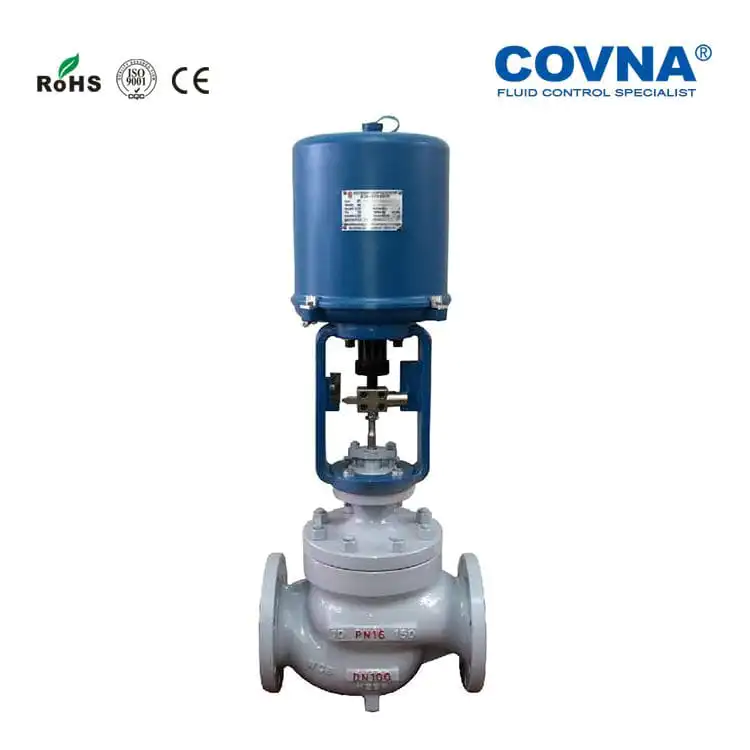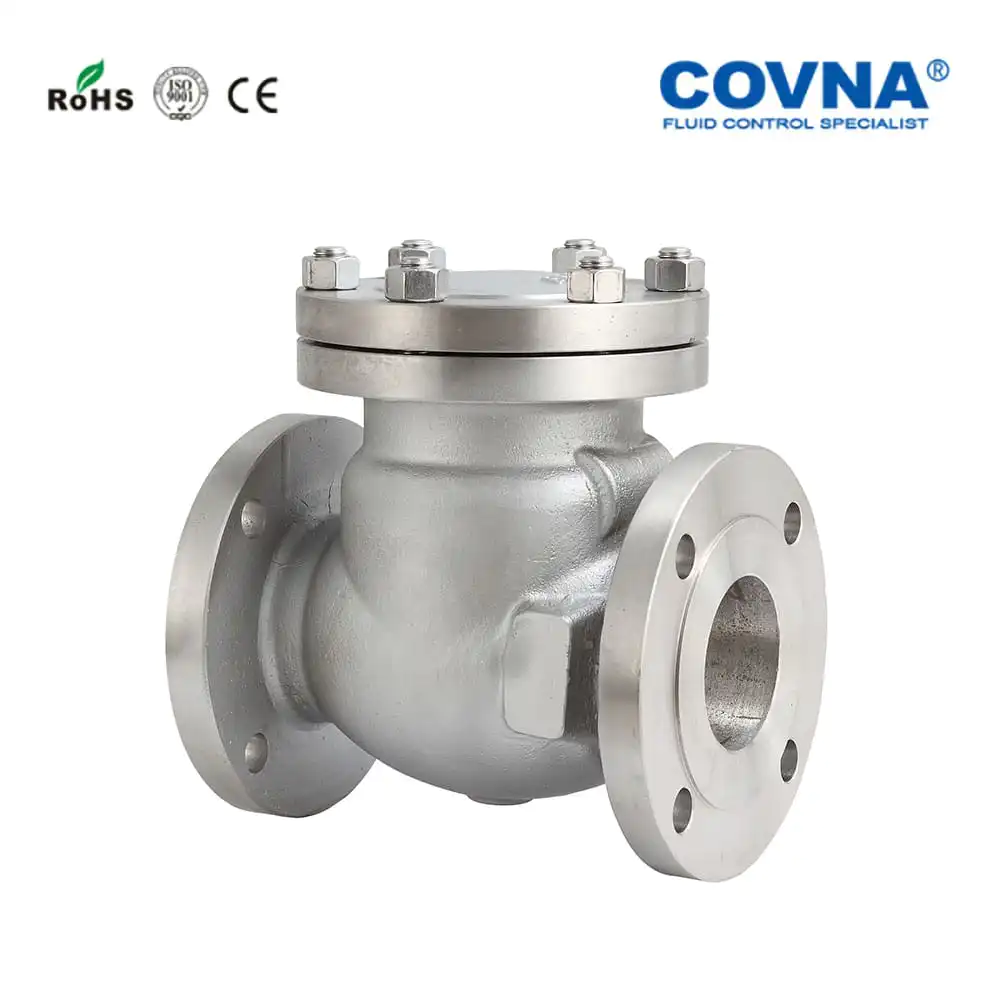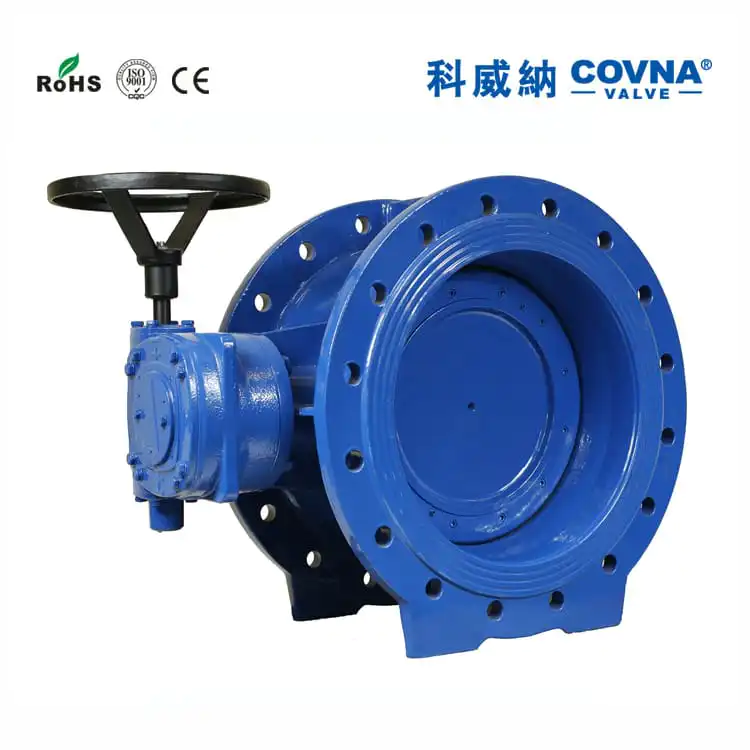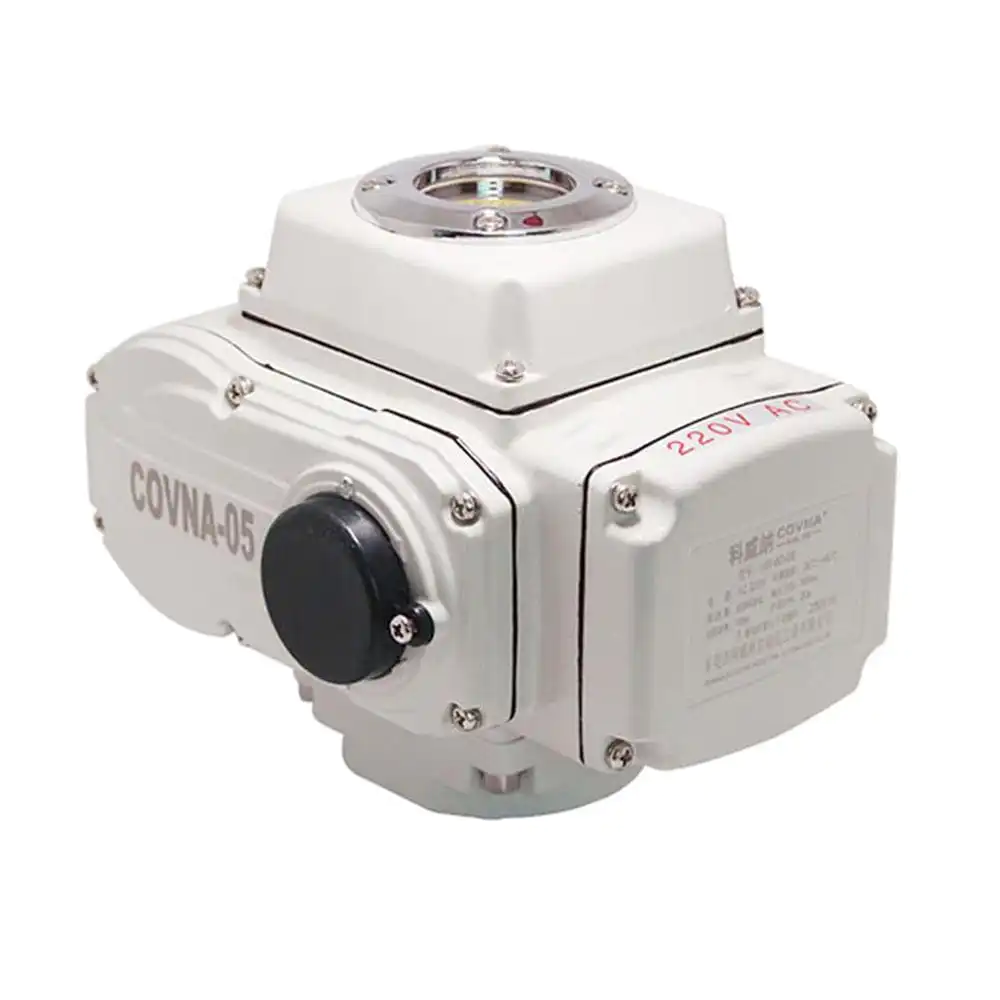COVNA Products
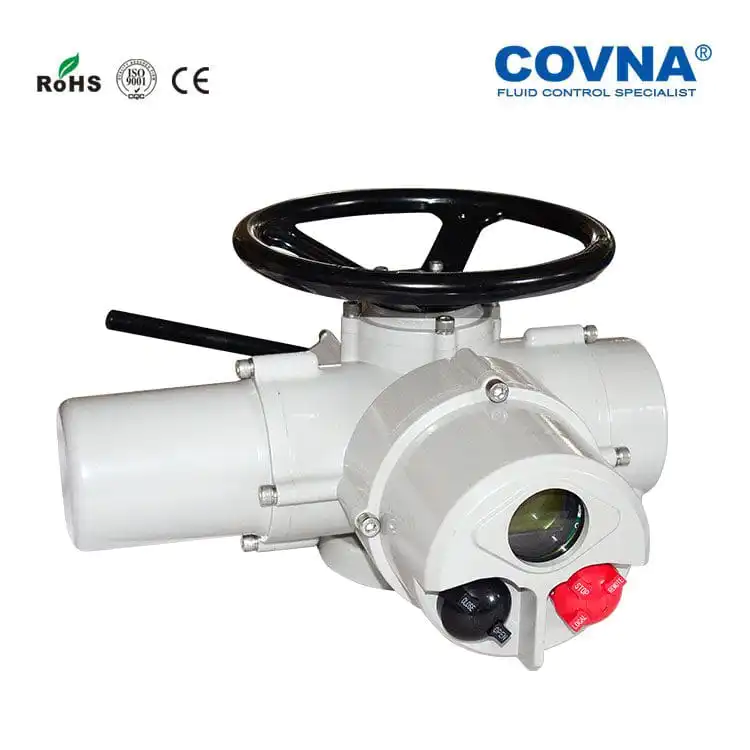
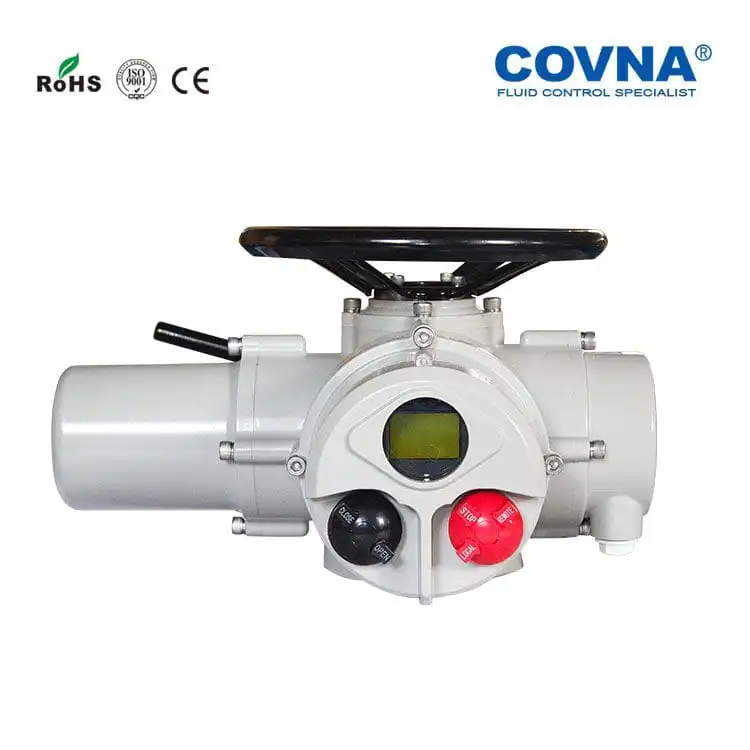

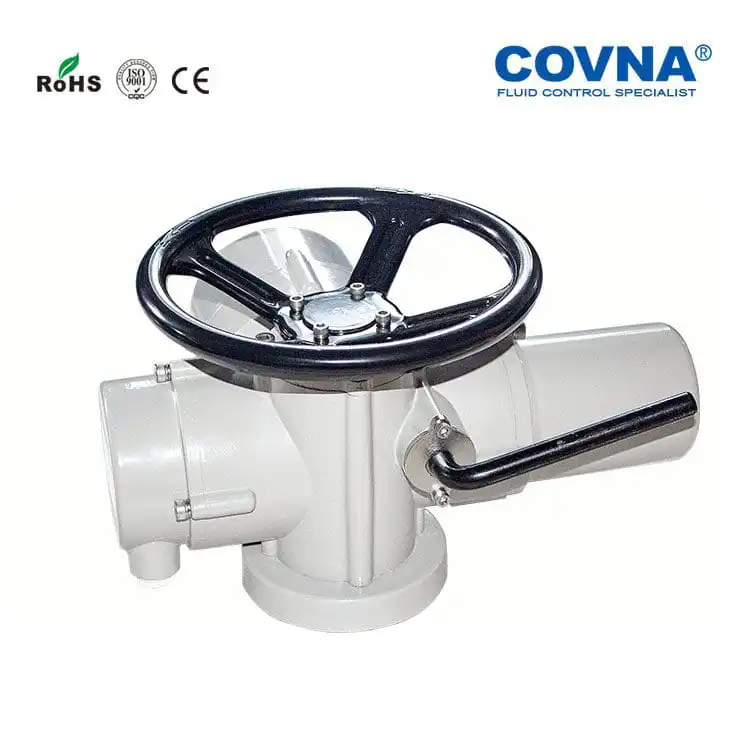
COVNA Multi-Turn Electric Actuator
Manufacturing
Multi-Turn Actuators
with 360 degrees rotation. The best motor operated valve actuators for a linear motion solution. Well for gate valve, knife gate valve, globe valve or ball valve and butterfly valve. High output torque up to 10,000Nm. Intelligent and easy to control. To allow your automation easier. Available in Profibus Fieldbus, Modbus Fieldbus, Hart Fieldbus, FF Fieldbus and Device Net Fieldbus.
COVNA will help you select the right valve and actuator basic on your requirement and save your time and cost. Consult us to get a right actuator and valve!
Model
- Type: Multi Turn Electric Actuator
- Material: Aluminum alloy
- Ambient Temperature: -20 to 70℃
- Protection Class: IP67
- Torque Range: 50Nm to10,000Nm
- Angle Of Rotation: 0° to 360°
- Voltage: 380VAC or 220VAC. Special voltage could be customized
● Benefits Of Multi-turn Electric Actuator:
COVNA Multi-turn rotary electric actuator with 360 degrees rotations range. Driven by AC/DC current, and can receive or feedback 4-20mA signal, it is compatible with major control systems, which is convenient for you to remotely control the on/off of the valve. Suitable for regulating the open/close of gate valves or globe valves. Meanwhile, multi-turn electric actuator with gearbox is suitable for the ball valve and butterfly valve which has a higher torque needs.
● Features Of Z Series Multi-Turn Electric Actuators:
1. Torque range from 50Nm to 10,000Nm
2. Available in 3 phase AC, 1 phase AC and DC motors
3. High protection class
4. Aluminum alloy shell, lightweight, anti-oxidation, anti-ultraviolet
5. Stainless steel 304 screws with the features of anti-corrosive for outdoor use
6. The valve can be controlled remotely, collectively and automatically
7. 360 degrees rotary electric motor actuators which suitable for gate valve, knife gate valve and globe valve
8. Widely used in power plant, petroleum, chemical, pharmaceutical, and other applications
9. Available in Profibus Fieldbus, ModbusFieldbus, HartFieldbus, FFFieldbus and Device NetFieldbus
10. According to functions, it could be divided into electric gate valve actuator, electric globe valve actuator, electric ball valve actuator, and electric butterfly valve actuator. To help your automation easier.




● Technical Parameters Of COVNA Multi-Turn Electric Actuators:
| Power Supply | 380V AC +10% / 50 Hz plus or mins 5%, or custom220V AC +10% / 50 Hz plus or mins 5%, or custom |
| Input Signals | A) Analog quantity 4mA-20mA DC, input impedance 250ΩB) On-of quantity active 24V DCC) The profibus-dp or MODUS (optional) |
| Output Signal | A) 4mA-20mA DC, load resistance 750Ω or lessB) 6 groups of passive contactsC) Profibus-DP or MODUS (optional) |
● Valve Optional:
ISO5211 mounting for butterfly valve, ball valve, gate valve, knife gate valve and globe valve. Widely used for food process solutions, water treatment plants, shipyards, power plants, paper and pulp, and other heavy industries

1.Oil and Gas Industry
Pipeline Flow and Pressure Control: Used for flow and pressure control in natural gas and oil pipelines to ensure stability during transportation.
Gas and Liquid Distribution Systems: Regulates the flow of gases or liquids, ensuring precise control under various operating conditions.
Automation of Distribution Systems: Used in refineries and natural gas processing plants to automate fluid distribution and regulate the reaction processes.
2.Chemical and Petrochemical Industry
Reactor Pressure and Flow Control: Used in chemical reactors, storage tanks, and other equipment to control pressure and flow, ensuring stability in the chemical reaction process.
Flow/Pressure Regulation: Regulates the flow of liquids or gases in processes such as polymerization, refining, and distillation to ensure efficient production.
Steam Control: Regulates the flow and pressure of steam in steam generators and distribution systems.
3.Water and Wastewater Treatment
Water Flow Control: Regulates water flow and pressure in water supply and wastewater treatment systems to ensure normal operation.
Gas and Chemical Additions: Regulates the flow of chemicals or gases (such as chlorine or ammonia) added during the water treatment process.
4.HVAC (Heating, Ventilation, and Air Conditioning) Systems
Temperature Control and Airflow Regulation: Used in air conditioning systems to regulate the flow of cooling or heating fluids to maintain the desired temperature.
Pressure and Airflow Regulation: Adjusts the flow and pressure of air in ventilation, air conditioning, and humidification systems to ensure indoor comfort.
5.Food and Beverage Industry
Liquid Flow Control: Precisely controls the flow of liquids in processes such as brewing, dairy production, and beverage bottling.
Temperature and Pressure Regulation: Regulates temperature and pressure during heating, cooling, and sterilization to ensure product quality and safety.
6.Pharmaceutical Industry
Precision Flow Control: Regulates the flow of liquids and gases in pharmaceutical manufacturing processes to ensure precise control of process parameters.
Pressure Control: Adjusts pressure in cleaning and sterilization systems to ensure stable system operation.
7.HVAC Systems
Airflow and Temperature Control: Controls the flow and temperature of air to adjust environmental conditions, ensuring comfort and energy efficiency inside buildings.
8.Steel and Metallurgical Industry
Gas Flow Control: Precisely adjusts the flow of gases such as oxygen and nitrogen during smelting and heating processes to ensure stable furnace temperatures and chemical reactions.
Cooling Fluid Flow Regulation: Regulates the flow of cooling fluids in cooling systems to ensure temperature control of equipment.
9.Thermal and Power Industry
Steam and Water Flow and Pressure Control: Regulates the flow of steam and water in boiler systems, heat exchangers, and power plants to ensure efficient operation of thermal systems.
10.Mining Industry
Slurry Flow Regulation: Adjusts the flow and pressure of slurry during transportation and separation processes to ensure efficient extraction and processing of minerals.
The actuator on my automated valve operates, but the valve won’t turn. Why?
Most likely the valve stem or actuator coupling is broken.
Why doesn’t my valve open or close completely when the actuator operates it?
The electric actuator limit switches or the pneumatic actuator position stops are not correctly adjusted.
When I energize the solenoid on my pneumatic actuated valve, the valve won’t turn. How come?
Probably because there is no air pressure to the solenoid or dirt has jammed it. Also, debris might be trapped inside the valve. Or, the air pressure is not sufficient to operate the actuator. Remember: measure air pressure at the actuator, not at the compressor.
Can I buy an actuator from one manufacturer and mount it to a valve from another manufacturer?
Maybe. First, be sure that the actuator torque output is sufficient to turn the valve reliably. Second, you will have to fabricate a custom mounting bracket and coupling to connect the actuator to the valve.
What happens if I lose power to my electric actuator in the middle of an actuation cycle?
The valve will stop somewhere between full open and close. When power is reapplied to the original circuit, the actuator will complete the cycle.
I ordered a fail open pneumatic actuated valve by mistake. I needed a fail closed one. What can I do?
To make the change just remove the actuator from the valve and turn it, or the valve stem, 90 degrees and remount the actuator.
I’ve installed my automated valve in the line, but now I don’t know if the valve is in the open or closed position. How can I find out?
Remove the actuator from the valve and check the valve stem. Most ball valves have stem flats at right angles to the flow when the valve is in the off position. On butterfly valves check the stem flow arrow marking.
Do I have to have the solenoid valve that controls the air supply to my pneumatic actuator mounted right on the actuator?
Remove the actuator from the valve and check the valve stem. Most ball valves have stem flats at right angles to the flow when the valve is in the off position. On butterfly valves check the stem flow arrow marking.
How do I wire up my electric actuator?
Check the electric wiring schematic that came with the actuator for the correct hookup. Sometimes a copy is inside the actuator cover. If it is missing, don’t guess about the connections. Call the manufacturer for a schematic.
I’ve just installed an electric actuated valve and when I power it, it turns the valve 360 degrees and won’t shut off. What’s wrong?
The actuator is wired incorrectly (check the schematic accompanying the actuator), or the external control switch is not the correct type for the actuator.
My electric actuators cycle time is way too fast, can I slow it down?
Not unless you bought it with an optional speed control.
I just replaced a solenoid valve with an electric actuated valve and it won’t work. Why?
Actuators and solenoid valves require different types of electrical control switches. SPDT for actuators, SPST for solenoids. Check the actuator wiring schematic for the correct wiring and switch type.




